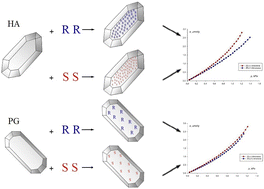Possibility of chiral recognition by adsorption on enantiomorphous crystals: the impact of crystal surface polarity†
Abstract
Chiral crystals remain one of the probable sources of first minute chiral symmetry breaking, a trigger that potentially causes an as-yet unknown type of asymmetric autocatalysis during the formation of chiral biopolymers under the conditions of the Archean Earth. Therefore, studying adsorption processes on the surface of such crystals may help improve the understanding of the nature of the initial chiral shift. The adsorptive activity of non-porous crystals with respect to the majority of organic molecules essentially depends on the ability of a crystal surface to engage in specific intermolecular interactions. In this work, the enantioselectivity provided by hippuric acid and phloroglucinol crystals, obtained under Viedma ripening conditions, was studied by the adsorption of menthol enantiomers from solutions and the adsorption of limonene and α-pinene enantiomers from vapors. To establish the reliability of chiral recognition, the experimental adsorption isotherms on chiral crystals were compared with the isotherms on achiral (racemic mixtures) crystals, obtained under similar conditions. The data obtained were confirmed using CD spectra, XRD patterns and SEM images. A t-test was used to assess the statistical significance of differences in adsorption. From the adsorption isotherms of vapors at different temperatures, the isosteric heats of adsorption and the differential entropies of adsorption were calculated. It was determined that the chiral recognition ability depends not only on the difference between enantiomers in the thermodynamic functions of adsorption, but also on the isosteric heats of adsorption at low coverages and the heat of liquefaction ratio. If intermolecular interactions between the enantiomer and the surface are too weak, then enantiomer layer formation becomes difficult. This reduces the enantioselectivity or even makes chiral recognition impossible. The physicochemical regularities revealed in this present work made it possible to formulate the requirements that enantiomorphous crystals must meet for satisfactory chiral recognition of molecules of different polarities.



 Please wait while we load your content...
Please wait while we load your content...